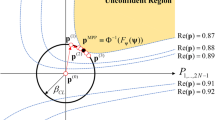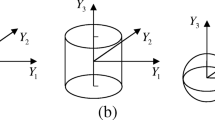Abstract
Reliability analysis and reliability-based design optimization (RBDO) require an exact input probabilistic model to obtain accurate probability of failure (PoF) and RBDO optimum design. However, often only limited input data is available to generate the input probabilistic model in practical engineering problems. The insufficient input data induces uncertainty in the input probabilistic model, and this uncertainty forces the PoF to be uncertain. Therefore, it is necessary to consider the PoF to follow a probability distribution. In this paper, the probability of the PoF is obtained with consecutive conditional probabilities of input distribution types and parameters using the Bayesian approach. The approximate conditional probabilities are obtained under reasonable assumptions, and Monte Carlo simulation is applied to calculate the probability of the PoF. The probability of the PoF at a user-specified target PoF is defined as the conservativeness level of the PoF. The conservativeness level, in addition to the target PoF, will be used as a probabilistic constraint in an RBDO process to obtain a conservative optimum design, for limited input data. Thus, the design sensitivity of the conservativeness level is derived to support an efficient optimization process. Using numerical examples, it is demonstrated that the conservativeness level should be involved in RBDO when input data is limited. The accuracy and efficiency of the proposed design sensitivity method is verified. Finally, conservative RBDO optimum designs are obtained using the developed methods for limited input data problems.









Similar content being viewed by others
Abbreviations
- CDF:
-
Cumulative distribution function
- PDF:
-
Probability density function
- PoF, p F :
-
Probability of failure
- G(x):
-
Performance measure
- Ω F :
-
Failure domain of a performance measure
- X, x :
-
Input random variable vector and its realization
- N :
-
Number (dimension) of input random variables
- X i :
-
i-th input random variable
- f X (x; ζ, ψ):
-
Joint PDF of X
- \( {f}_{X_i}\left({x}_i;{\zeta}_i,{\mu}_i,{\sigma}_i^2\right) \) :
-
Marginal PDF of X i
- Z, ζ :
-
Input distribution types and their realizations
- ζ i :
-
Marginal distribution type of X i
- Ψ, ψ :
-
Input distribution parameters and their realizations
- M i , μ i :
-
Input mean of \( {X}_i \) and its realization
- Σ 2 i , σ 2 i :
-
Input variance of \( {X}_i \) and its realization
- *x :
-
Input data set, *x = {*x 1, …, *x N }
- *x (j) i , *x i :
-
Input data and data set for X i
- ND :
-
Number of input data
- \( {}^{*}{\overline{x}}_i{,}^{*}{\overline{\mathbf{x}}}_i \) :
-
Mean of input data and its vector form
- \( {}^{*}{\tilde{x}}_i{,}^{*}{\tilde{\mathbf{x}}}_i \) :
-
Dispersion of input data and its vector form
References
Aughenbaugh JM, Paredis CJJ (2006) The value of using imprecise probabilities in engineering design. J Mech Des 128(4):969–979
Breitung K (1984) Asymptotic approximations for multinormal integrals. J Eng Mech 110(3):357–366
Chick SE (2001) Input distribution selection for simulation experiments: accounting for input uncertainty. Oper Res 49(5):744–758
Ditlevsen O, Madsen HO (1996) Structural reliability methods. Wiley, Chichester
Du L, Choi KK (2008) An inverse analysis method for design optimization with both statistical and fuzzy uncertainties. Struct Multidiscip Optim 37(2):107–119
Elishakoff I (2004) Safety factors and reliability: friends or foes? Kluwer Academic Publishers, Dordrecht
Gelman A, Carlin JB, Stern HS, Rubin DB (2004) Bayesian data analysis, 2nd edn. Chapman & Hall/CRC, Boca Raton
Gumbert CR, Hou GJW, Newman PA (2003) Reliability assessment of a robust design under uncertainty for a 3-D flexible wing. Proc. 16th AIAA Computational Fluid Dynamics Conference, Orlando
Gunawan S, Papalambros PY (2006) A Bayesian approach to reliability-based optimization with incomplete information. J Mech Des 128(4):909–918
Haldar A, Mahadevan S (2000) Probability, reliability and statistical methods in engineering design. Wiley, New York
Hasofer AM, Lind NC (1974) Exact and invariant second-moment code format. J Eng Mech Div ASCE 100(1):111–121
Hohenbichler M, Rackwitz R (1988) Improvement of second‐order reliability estimates by importance sampling. J Eng Mech 114(12):2195–2199
Hou GJW (2004) A most probable point-based method for reliability analysis, sensitivity analysis, and design optimization. NASA/CR-2004-213002, NASA
Lee I, Choi KK, Gorsich D (2010) System reliability-based design optimization using the MPP-based dimension reduction method. Struct Multidiscip Optim 41(6):823–839
Lee I, Choi KK, Noh Y, Zhao L, Gorsich D (2011a) Sampling-based stochastic sensitivity analysis using score functions for RBDO problems with correlated random variables. J Mech Des 133(2):021003
Lee I, Choi KK, Zhao L (2011b) Sampling-based RBDO using the stochastic sensitivity analysis and dynamic kriging method. Struct Multidiscip Optim 44(3):299–317
Lee I, Noh Y, Yoo D (2012) A novel Second-Order Reliability Method (SORM) using non-central or generalized chi-squared distributions. J Mech Des 134(10):100912
Lim J, Lee B, Lee I (2014) Second-order reliability method-based inverse reliability analysis using hessian update for accurate and efficient reliability-based design optimization. Int J Numer Methods Eng 100(10):773–792
Noh Y, Choi KK, Lee I, Gorsich D, Lamb D (2011a) Reliability-based design optimization with confidence level under input model uncertainty due to limited test data. Struct Multidiscip Optim 43(4):443–458
Noh Y, Choi KK, Lee I, Gorsich D, Lamb D (2011b) Reliability-based design optimization with confidence level for non-gaussian distributions using bootstrap method. J Mech Des 133(9):091001
Rahman S, Wei D (2006) A univariate approximation at most probable point for higher-order reliability analysis. Int J Solids Struct 43(9):2820–2839
Rahman S, Wei D (2008) Design sensitivity and reliability-based structural optimization by univariate decomposition. Struct Multidiscip Optim 35(3):245–261
Rubinstein RY, Kroese DP (2008) Simulation and the Monte Carlo method, 2nd edn. Wiley, Hoboken
Tu J, Choi KK, Park YH (1999) A new study on reliability-based design optimization. J Mech Des 121(4):557–564
Tu J, Choi KK, Park YH (2001) Design potential method for robust system parameter design. AIAA J 39(4):667–677
Tucker WT, Ferson S (2003) Probability bounds analysis in environmental risk assessment. Applied Biomathematics, Setauket
Utkin L, Destercke S (2009) Computing expectations with continuous P-Boxes: univariate case. Int J Approx Reason 50(5):778–798
Youn BD, Choi KK (2004) A new response surface methodology for reliability-based design optimization. Comput Struct 82(2–3):241–256
Youn B, Wang P (2008) Bayesian reliability-based design optimization using Eigenvector Dimension Reduction (EDR) method. Struct Multidiscip Optim 36(2):107–123
Zhang R, Mahadevan S (2000) Model uncertainty and bayesian updating in reliability-based inspection. Struct Saf 22(2):145–160
Acknowledgments
Research was supported by the Automotive Research Center (ARC) in accordance with Cooperative Agreement W56HZV-04-2-0001 U.S. Army Tank Automotive Research, Development and Engineering Center (TARDEC). This research was partially supported by high-performance computer time and resources from the DOD High Performance Computing Modernization Program, and the Technology Innovation Program (10048305, Launching Plug-in Digital Analysis Framework for Modular System Design) funded by the Ministry of Trade, Industry & Energy (MI, Korea). These supports are greatly appreciated.
Author information
Authors and Affiliations
Corresponding author
Appendix A
Appendix A
Rights and permissions
About this article
Cite this article
Cho, H., Choi, K.K., Gaul, N.J. et al. Conservative reliability-based design optimization method with insufficient input data. Struct Multidisc Optim 54, 1609–1630 (2016). https://doi.org/10.1007/s00158-016-1492-4
Received:
Revised:
Accepted:
Published:
Issue Date:
DOI: https://doi.org/10.1007/s00158-016-1492-4




